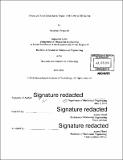| dc.contributor.advisor | Anette Hosoi. | en_US |
| dc.contributor.author | Fitzgerald, Meaghan (Meaghan E.) | en_US |
| dc.contributor.other | Massachusetts Institute of Technology. Department of Mechanical Engineering. | en_US |
| dc.date.accessioned | 2016-12-05T19:58:54Z | |
| dc.date.available | 2016-12-05T19:58:54Z | |
| dc.date.copyright | 2016 | en_US |
| dc.date.issued | 2016 | en_US |
| dc.identifier.uri | http://hdl.handle.net/1721.1/105708 | |
| dc.description | Thesis: S.B., Massachusetts Institute of Technology, Department of Mechanical Engineering, 2016. | en_US |
| dc.description | Cataloged from PDF version of thesis. | en_US |
| dc.description | Includes bibliographical references (page 37). | en_US |
| dc.description.abstract | In an effort to better understand impacts with gates during ski racing competition, on-snow measurements and observations were made of both standard gates and inflatable gates. These observations highlighted the importance of impact force and time. Two additional experiments were done to analyze these factors and compare their values for standard gates and inflatable gates. Gates were hit with a controlled weighted pendulum and force sensor to measure the impact force. To measure time, slow motion footage was taken of the gates clamped in a baseball pitching machine. The baseball's velocity was scaled to model the skier using conservation of energy principles. The footage was analyzed with position tracker software. Inflatable gates were found to have a lower mean impact force of 28.55 ± 5.89 N compared to the standard gate impact force of 44.55 ± 7.12 N. Although they exhibited lower impact force, the inflatable gates had a longer time to clear out of the skier travel path due to isolated bending in the small area of impact. The time for the tip of the inflatable gate to clear was 0.63 ± 0.1s compared to the 0.43 ± 0.03s it took for the tip of the standard gate to clear. From these results, it can be concluded that inflatable gates have a softer impact force, but require a modification in racing form in order to increase the impact area and thus decrease momentum and balance losses due to gate bending around extremities. | en_US |
| dc.description.statementofresponsibility | by Meaghan Fitzgerald. | en_US |
| dc.format.extent | 37 pages | en_US |
| dc.language.iso | eng | en_US |
| dc.publisher | Massachusetts Institute of Technology | en_US |
| dc.rights | M.I.T. theses are protected by copyright. They may be viewed from this source for any purpose, but reproduction or distribution in any format is prohibited without written permission. See provided URL for inquiries about permission. | en_US |
| dc.rights.uri | http://dspace.mit.edu/handle/1721.1/7582 | en_US |
| dc.subject | Mechanical Engineering. | en_US |
| dc.title | Forces and time delay due to impact with gates in ski racing | en_US |
| dc.type | Thesis | en_US |
| dc.description.degree | S.B. | en_US |
| dc.contributor.department | Massachusetts Institute of Technology. Department of Mechanical Engineering | |
| dc.identifier.oclc | 964661086 | en_US |
